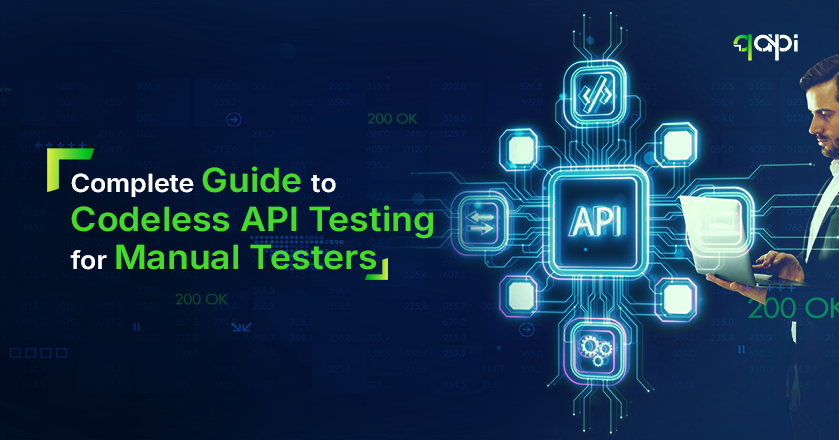Is manual testing still relevant in 2025? We often hear that manual testing is struggling big time to keep up with the pace of development with AI led tools today. Most testers would agree to this.
As the number of digital tools and services keeps growing, it’s natural that API testing will become a critical skill for modern QA professionals. For manual testers who have always focused on UI testing, transitioning to API automation can be challenging—especially when coding skills are limited or non-existent.
However, when done right, a codeless API testing tool can bridge this gap by helping manual testers automate API testing without writing a single line of code.
With 84% of developers now using AI tools in some way, and API-driven development becoming the norm, manual testers who leverage codeless automation can position themselves for significant career growth and expanded opportunities.
Below are what testers have shared with me in recent years about what is important to them when it comes to API testing.
But first, to make sure we’re synced, let’s look at why API testing is so important.
Why API Testing Should Be Your First Priority
The software testing industry today faces a significant skills gap, with manual testers often feeling left behind as organizations increasingly prioritize faster output, thus trusting automation.
We’ve seen product leaders and owners getting frustrated when operations are disrupted, new features that are supposed to be launched are delayed.
Modern applications integrate with dozens of APIs, each requiring validation of multiple endpoints, parameters, and response scenarios. Manual testing approaches cannot keep pace with this complexity.
Because each code change requires manual verification of multiple API endpoints, it consumes developer time that should focus on feature development.
In the How Big Tech Companies Manage Multiple Releases study, we conducted. It was found that nearly 72% of testers and developers are interested in using a tool that helps them save time writing and testing APIs.
Automating API tests has the upside of reducing expensive post-release fixes, reducing the risk of downtime and additional support costs. In that study, one tester said they wish they knew “The amount of efforts that can be saved by Intelligent API testing automation”. Another said they wished “They knew about end-to-end API testing earlier, because at times they spent just rewriting the same tests, which were just a click away on qAPI”
These feelings are still quite actively found on social media. One Redditor asked, “How do you decide how much API testing is enough?”
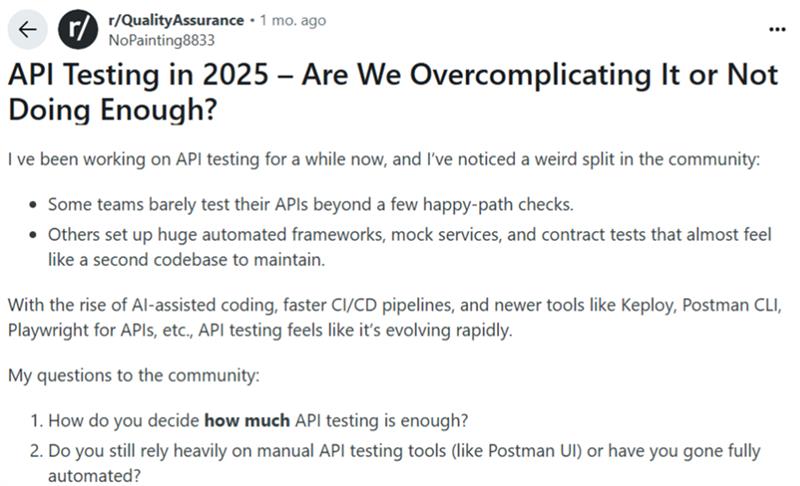
I think this says a lot about what the tester community feels about API testing. Everyone is aware of the challenges they have.
Only a handful of people have a clear understanding of how to leverage automation and a fraction of them know how to use AI for API testing without writing code.
With time, companies have both the power and responsibility to guide the masses to adapt and improvise but also support them and understand their concerns. Qyrus saw the problems their teams faced with API testing, they saw it happening across industries.
Following this insight, they created solutions for enterprises and individuals—making API testing accessible for all.
How To Move Towards End-To-End API Testing the Right Way
Contrary to popular belief, manual testers possess do have the right skills that give them an advantage in API testing:
• Deep understanding of business logic and user behavior
• Experience identifying edge cases and unexpected scenarios
• Strong analytical skills for interpreting test results
• Domain expertise that AI cannot replicate
• Intuitive grasp of what constitutes meaningful test coverage
Manual testers can use this exposure in user behavior, business logic, and edge cases that automated tools cannot intuit. When combined with qAPI, these skills become amplified rather than replaced.
Your APIs often communicate with each other, retrieve data from various systems, and initiate downstream processes. This inclusivity needs to come out during the API testing process.
That’s where end-to-end API testing comes in. Instead of testing just one piece, you’re validating the entire workflow—making sure APIs, databases, and services all work together seamlessly.
Think about it like this:
• A simple test can verify whether a login API returns a 200 status200-status code.
• An end-to-end test goes further: login → fetch user profile → update profile → confirm that the change reflects in the database and UI.
This approach will give you confidence that your product works the way your users expect!
Why Testing Your API End-to-End Makes a Difference?
• Catches integration bugs early – It’s not enough to know each API works independently; you need to validate that they work in sequence.
• Reduces reliance on UI testing – UI automation is fragile and time-consuming. API workflows test the same logic faster and with fewer false failures.
• Supports scalability – As your app grows, so does the number of APIs. End-to-end coverage ensures that as you scale, your foundations remain stable.
• Get Virtual users– To understand the limitations of your APIs, you need virtual users, and qAPI offers a way to choose how many you need. So you only pay for what you need.
• Bridges QA and Dev – Developers focus on unit testing APIs; testers extend that into real business scenarios across multiple APIs.
How Manual Testers Can Progress Towards End-to-End API Testing
Take the time to ensure that the product you plan to develop is well thought out.
1) Start with single endpoint validations.
• Validate basic responses: status codes, response times, key fields in the payload.
• Example: “Does the login API return the correct token format?”
2) Chain multiple requests together.
• Simulate actual workflows by passing data from one response into the next request.
• Example: Use the login token to fetch user details → then update user details.
3) Introduce data-driven testing.
• Instead of testing with one fixed value, try multiple inputs (valid, invalid, empty).
• Example: Test login with different credential sets or edge cases.
4) Expand to regression suites.
• Build reusable collections of API tests that can run after every deployment.
• Example: Automatically validate critical APIs (auth, payments, search) after each release.
5) Add monitoring or scheduled runs.
• Treat your API tests as ongoing health checks, not just one-time validations.
• Example: Run tests daily or hourly to detect issues in production environments early.
With qAPI, you can directly import your Postman/Swagger collection, and the system will not only create test cases but also automatically help chain them into workflows. Instead of manually coding logic for “use token from API A in API B,” qAPI handles that for you.
Mindset Shift for Manual Testers
The biggest change when moving toward end-to-end API testing isn’t technical—it’s conceptual. Instead of asking Why should you automate? Ask what I will get if I automate:
Instead of asking “Does this API work?” You start asking:
“Does this workflow work the way a real user needs it to?”
This shift makes manual testers more valuable. You’re not just checking buttons and forms—you’re validating the core logic of the application in a way that scales with the product.
So, How Does qAPI Work
• Reuse: qAPI lets you capture API interactions and convert them into reusable test cases
• Template-Based Creation: Pre-built templates for common API testing scenarios
• Visual Workflow Builders: Drag-and-drop interfaces for creating complex test scenarios
• AI-Powered Test Generation: Intelligent systems that suggest test cases based on API documentation
• Deploy Virtual Users: qAPI helps you test your APIs for functionality and performance with as many users as you want.
Here’s how it works-
All you need to do is sign up on qapi.qyrus.com
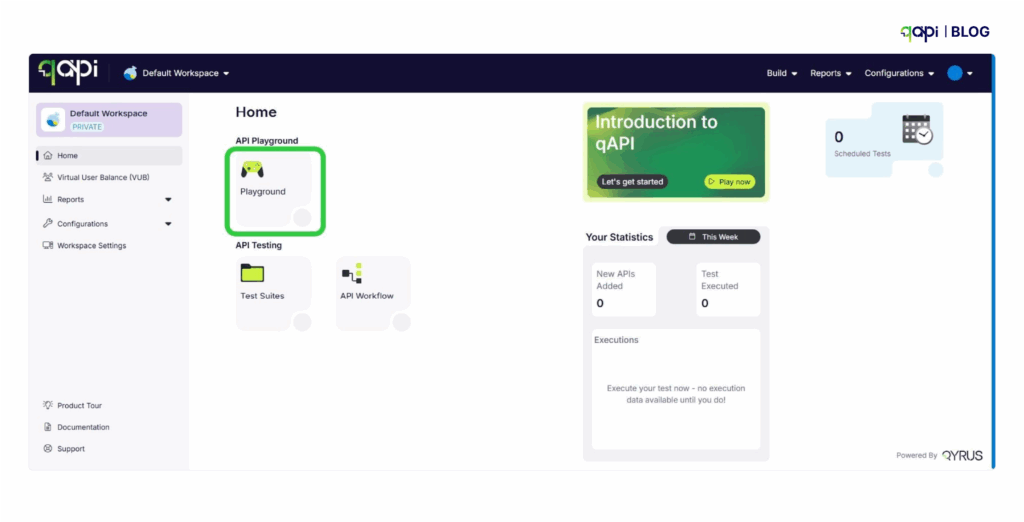
Select the new icon to add your API collection. In this case let’s use a Postman collection.
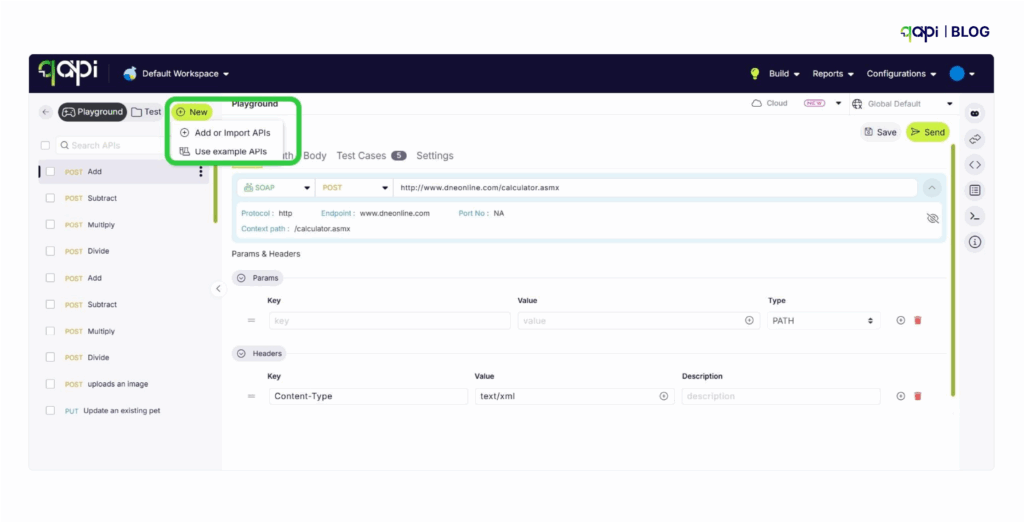
Click on add APIs, choose the import API option, and add the link.
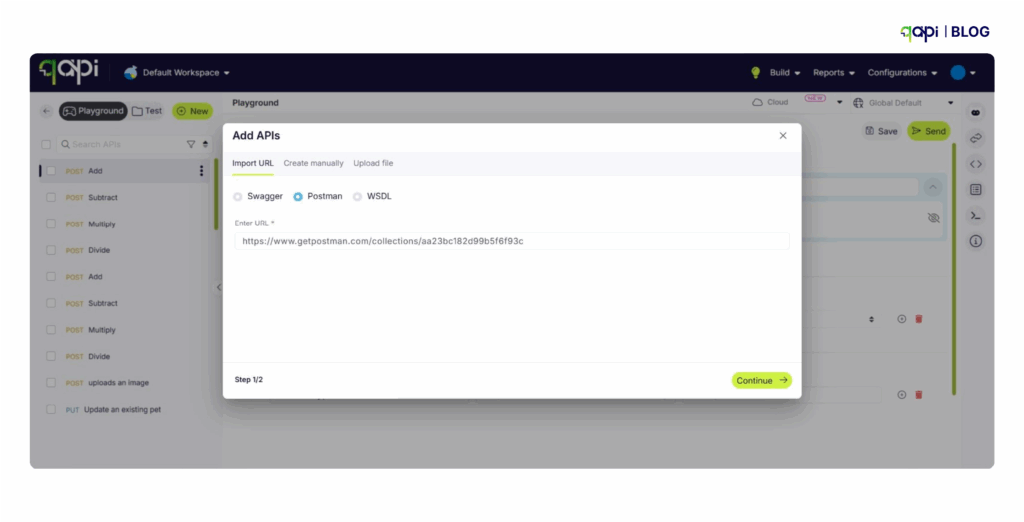
Once added, select all the endpoints you need. Here, I’ll select all and click on add to test.
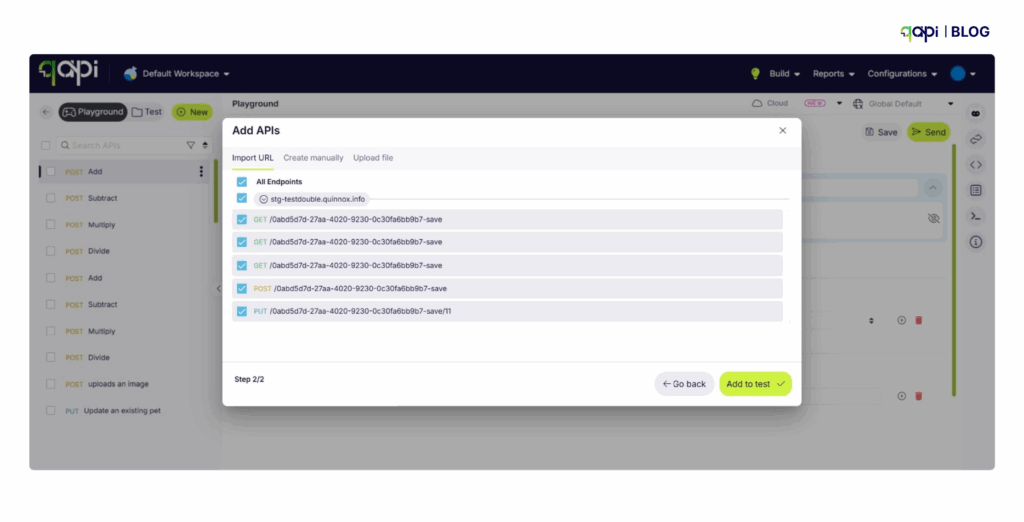
Select the API, check all the details and ensure all details are as per the requirements. You don’t need to edit anything. qAPI auto-fills all the boxes.
All you need to do is click a few buttons, as you can see that the test cases tab is empty.
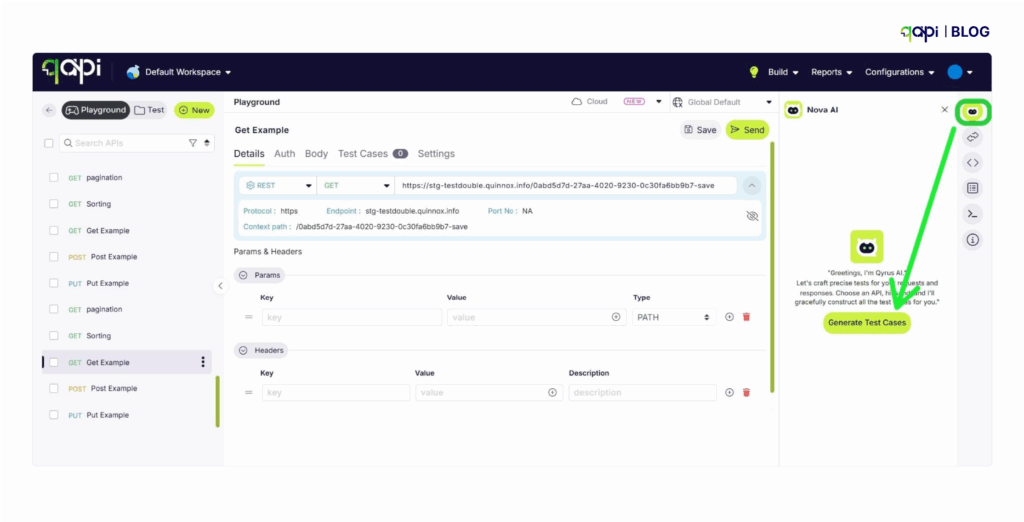
To generate test cases, click on the bot icon in the right section of the screen, as shown in the image above. Click to generate test cases.
Now there’s a faster way to deal with these if you want to generate test cases for all of them at once.
All you need to do is put them in a test suite, select all APIs, and create one group as shown in the image below.
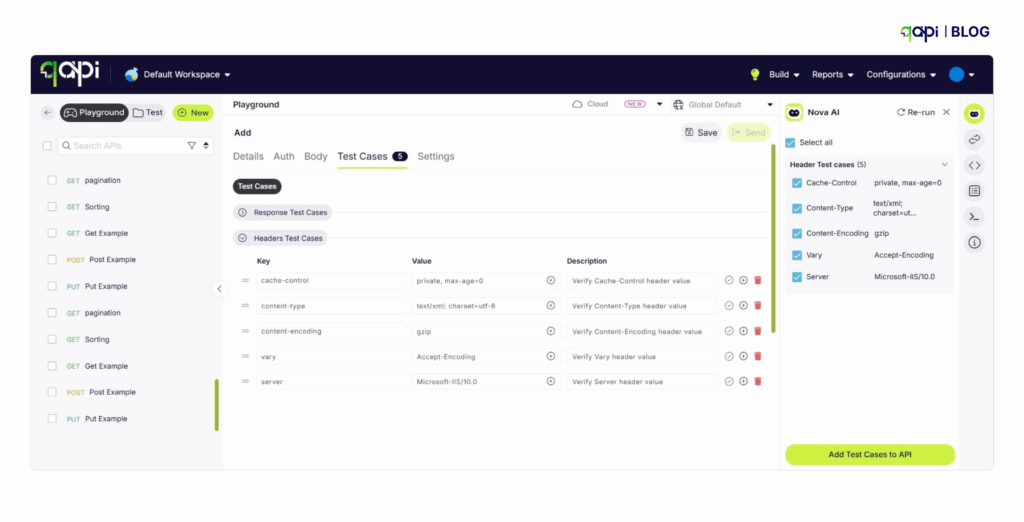
Once added, select the test suite and click on the bot icon in the right section of the screen.
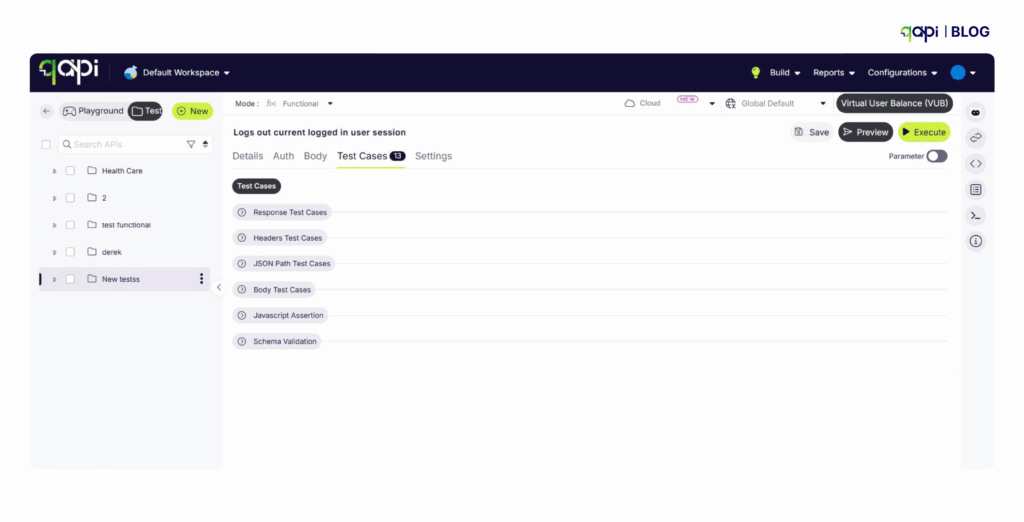
Select the test cases you want; simply tick the ones you want. In this case, I’m selecting all of them.
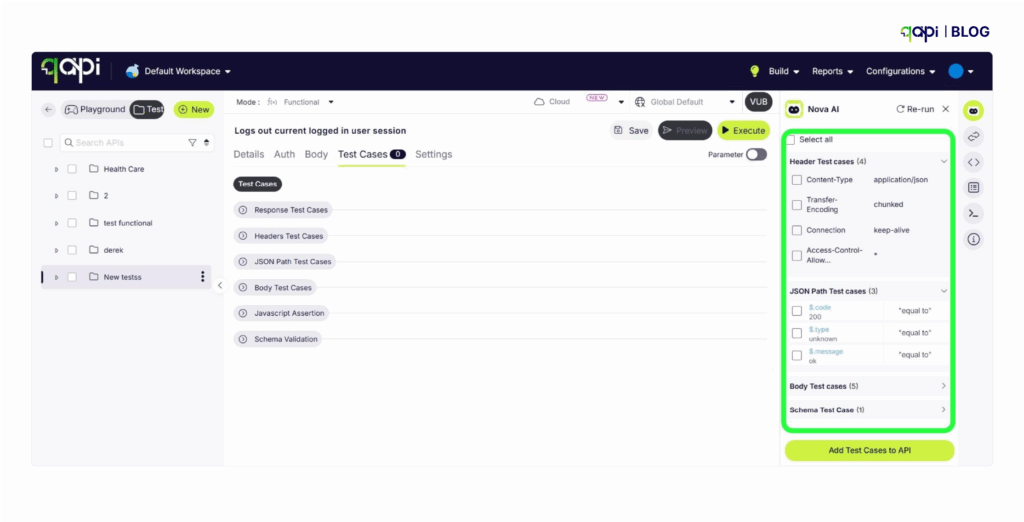
All test cases have now been added to the test suite.
Hit on execute to run tests.
The Application will take you to the reports dashboard, where you can open it to get a detailed breakdown.
You can even download the reports for further evaluation.
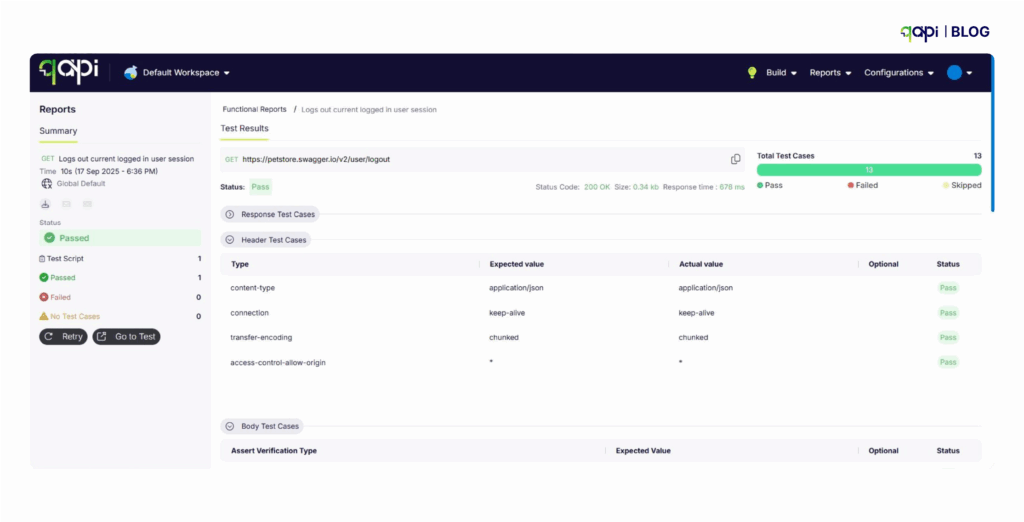
qAPI – the Only End-to-End API testing tool
The transition from manual to codeless API testing represents not just a career enhancement opportunity but a necessity in today’s rapidly evolving software development landscape. Manual testers possess unique skills—business domain knowledge, user behavior understanding, and critical thinking capabilities—that become exponentially more valuable when combined with codeless automation tools.
The key to success lies in recognizing that codeless API testing doesn’t replace manual testing expertise; it amplifies it. By starting with qAPI and following a simple learning path, and focusing on high-value automation scenarios, manual testers can successfully bridge the skills gap and position themselves for long-term career growth.
The statistics are clear: organizations implementing API test automation see substantial ROI, and the demand for professionals who can effectively combine manual testing insights with automated testing capabilities continues to grow. The question isn’t whether manual testers should embrace codeless API testing—it’s how quickly they can begin their transformation journey.
For manual testers: take the next step, the path forward is clear: start with using qAPI, choose the ideal process to help you keep on track of your deliverables and remember that your existing testing expertise is not a liability to overcome, but an asset that you need to leverage in the age of intelligent test automation.
FAQs
Codeless platforms can cover most daily needs—CRUD flows, schema checks, auth, data‑driven tests, CI/CD runs, and parallelization—so they replace code for a large share of work; for complex logic, niche protocols, or deep failure injection, a hybrid model (codeless for breadth, code for edge cases) remains best.
Know API basics (methods, headers, status codes), read OpenAPI/Swagger, design positive/negative and data‑driven tests, use visual assertions, and understand environments and CI results; no programming is required to begin, just figure out the logic and expand your command with practice.
They use schema‑based assertions, reusable steps, parameterization, versioned test assets tied to contracts, and AI‑assisted self‑healing; combine these with good hygiene—clean test data, modular flows, meaningful assertions, and quarterly pruning—to keep signals stable.
Prioritize OpenAPI import and contract‑aware test generation, strong data‑driven testing, mocking/virtualization, fast CI/CD integration with clear transparency, parallel execution, and readable dashboards; ensure security and performance are bang on it, plus it should be an easy learning curve for non‑coders.
Run a 90‑day before/after: track PR feedback time, flakiness rate, contract‑break frequency, critical‑path coverage, escaped defects, MTTR, release frequency, and cost‑per‑defect; show faster feedback, fewer production issues, and reduced manual effort to justify investment.
